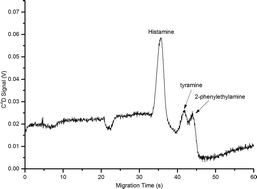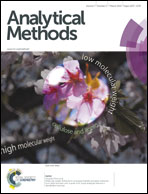Direct detection of histamine in fish flesh using microchip electrophoresis with capacitively coupled contactless conductivity detection†
Abstract
We demonstrate the use of microchip electrophoresis with capacitively coupled contactless conductivity detection (C4D) for the direct detection of histamine in fish flesh samples. Optimization of the background electrolyte (BGE) conditions showed that a competitive detection limit of 0.43 mg L−1 was achievable using a mixed 2-[4-(2-hydroxyethyl)piperazin-1-yl]ethanesulfonic acid and histidine BGE at pH 6.03. The developed method was successfully applied to the determination of spiked histamine in yellowfin tuna flesh samples with recoveries ranging from 88.8 to 112.5% with relative standard deviations below 13%. Further versatility of the method was demonstrated with the analysis of histamine levels in four frozen fish samples, purchased from a local supermarket, showing all contained concentrations well below the Australian and New Zealand Food Standards Code maximum limit for decomposition (200 μg g−1). The reported method eliminates the need for analyte derivatization associated with common optical detection techniques and the use of C4D offers increased portability. Further, this approach could easily be adapted for the detection of histamine in other food and beverage samples.


 Please wait while we load your content...
Please wait while we load your content...